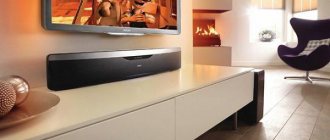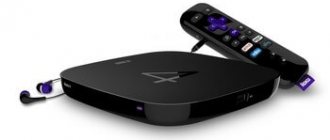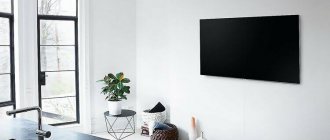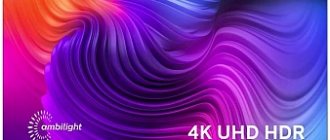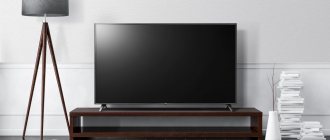For a long time I did not want to sit down to write this article, and not even because I was lazy, but simply the topic of connecting Bluetooth headphones to TVs with Smart TV is very “dark”. It all started when I bought myself Bluetooth headphones and connected them to my Philips TV, which runs Android TV. Everything connected very simply and without problems. I thought why not write detailed instructions on connecting wireless headphones to TVs. Moreover, many modern TVs have Bluetooth support.
But somehow I didn’t really want to write only about Philips TVs, so I decided to make general instructions and show how you can connect Bluetooth headphones to LG, Samsung and Sony TVs. Since I don’t have these TVs, and I can’t check everything from personal experience, I started looking for information on the Internet. And then it began. If Philips and Sony TVs that run on Android TV connect without problems to wireless headphones, then LG with webOS and Samsung Smart TV are a complete mess.
It is clear that the TV must have a built-in Bluetooth adapter. But you probably know that almost all TVs work only with original devices (cameras, adapters, remote controls, etc.). It's about the same story with headphones. You can easily connect an original Bluetooth stereo headset to LG and Samsung TVs. But it’s unlikely that you’ll be able to connect regular headphones. But it depends on the TV model, series, firmware version, year of production and God knows what else. The mess is such that after studying this topic for several hours, my brain boiled.
It seems that new Samsung TV models can already connect any Bluetooth headphones. There is also a service menu where you can try to enable support for this function. But again, it all depends on the series and model. LG has about the same story. And if you believe LG support, then you can only connect original headphones. But again, not on all models.
To avoid confusion, I will divide this article into three sections. I’ll tell you about each manufacturer separately. I'll show you how you can try connecting Bluetooth headphones in the TV settings.
In order not to waste time, I advise you to immediately make sure that your TV has built-in Bluetooth (if you have a Smart TV, then most likely it does). In some models it must be connected with a separate proprietary adapter. You can see the characteristics of your model on the official website.
If your TV does not have Bluetooth, or it flatly refuses to see headphones, then you can use a special Bluetooth transmitter that connects to the 3.5 mm output of the TV (it is also possible to connect via RCA (tulip), or optical audio output), and they will already connect to it headphones. I will tell you more about such adapters at the end of the article (or read the article about Bluetooth transmitters at the link above).
Rating of the TOP 10 best wireless headphones Sony 2020-2021
| Place | Name | Price |
| TOP 10 best wireless headphones | ||
| 1 | Sony WH-XB900N | Find out the price |
| 2 | Sony WI-1000XM2 | Find out the price |
| 3 | Sony WH-1000XM3 | Find out the price |
| 4 | Sony WF-1000XM3 | Find out the price |
| 5 | Sony WI-C200 | Find out the price |
| 6 | Sony WH-CH510 | Find out the price |
| 7 | Sony WH-CH700N | Find out the price |
| 8 | Sony WI-C400 | Find out the price |
| 9 | Sony WH-CH400 | Find out the price |
| 10 | Sony WH-CH500 | Find out the price |
Radio headphones for TV
Radio headphones for TV are less popular compared to their counterparts equipped with Bluetooth and are mainly used for TVs without a Bluetooth module. Therefore, we will consider only the 2 most popular models from Sony and Sennheiser.
Sony MDR-RF855RK
At first glance, the Sony MDR-RF855RK headphones may seem too large and heavy to the user. However, the volumetric weight is explained by the capacious battery, which, by the way, none of this list can compare with. Sony made it possible to use radio headphones for 25 hours of continuous operation. By the way, the transmitted radio signal reaches the listener without any interference. The kit comes with a transmitter equipped with 3 channels. In addition, the rejection of Bluetooth technology allows you to use headphones within a radius of 100 meters.
Pros:
- Long-term service life;
- Large-capacity battery designed for 24 hours of uninterrupted operation;
- Headphone adjustment;
- Radio signal reception within a radius of 100 m.
Minuses:
- The ear pads are not durable;
- Wireless use only;
- The quality of music listening leaves much to be desired;
- Can pick up other radio signals.
Sennheiser RS 175
The Sennheiser RS 175 headphones come with a huge base. Its goal is to deliver the audio radio signal in the best possible way. The headphones are located in the luxury segment, so the chances that a neighbor will use and cause interference are extremely small. The weight of the accessory is 310 grams, and the sensitivity to radio signals is 114 dB. Radio headphones are universal in use - suitable for both music and watching a movie on TV.
Pros:
- Radio signal reception in any conditions;
- Long term service;
- Large battery designed for 18 hours of uninterrupted operation;
- Digital optical input;
- No noise.
Minuses:
- High price;
- Operates exclusively on AAA power types.
How to choose and what to pay attention to?
Modern Sony wireless headphones have both vacuum in-ear and full-size headphones, as well as earbuds (plugs).
Everyone can choose an option to their liking: for listening to music in a quiet environment, in transport, while walking, for working out in the gym or for running.
When making a choice, consider the following nuances:
- Many noise-canceling headphones do not have their own volume control. You can only increase or decrease the volume on the connected device itself.
- If the battery is stored at temperatures above 35 and below 15 degrees, charging problems will occur.
- Make sure that the contact connector with the cable is clean: contamination will prevent the device from fully charging.
- If you need a device to listen to music while walking, choose in-ear vacuum headphones, in the form of earbuds that do not allow moisture to pass through. For sports - which are inserted into the ear canal.
Connecting Bluetooth headphones to a Samsung TV
Let's move on to Samsung TVs, which have complete confusion on this topic. As I already wrote at the beginning of the article, it seems that new models of certain series support connecting Bluetooth headphones from any manufacturer. At least I saw a video where Beats headphones were connected to a J series TV without any problems.
I don’t know what Samsung TV you have, what firmware it has, Smart TV version, etc., but I advise you to try it. What if everything works out and works.
Connect: Open the TV settings. Go to the “Sound” – “Speaker Settings” section. Turn on your Bluetooth headphones and place them next to the TV. They must be in connected mode. The blue indicator should flash. Select "Bluetooth Headphone List".
If you do not have the “List of Bluetooth headphones” item, or it is inactive, then you can try activating it in the service menu of the TV. More on this below in the article.
Menu appearance may vary slightly.
Next, the TV should find our wireless headphones.
Select them and the devices will be paired. The sound from the Samsung TV will be transmitted via Bluetooth to the headphones. If you turn them off, the sound will come through the TV speakers.
For K series TVs
In the settings you need to open the “Sound” section, then “Select speaker” and “Bluetooth Audio”.
Activating the “List of Bluetooth headphones” section in the service menu
I will not describe the whole process, but will simply add a video in which the author explains and shows everything in detail. There you can see the entire connection process.
If you managed to enable support for Bluetooth headphones on a Samsung TV using the service menu, then write about it in the comments to this article, and don’t forget to say thank you to the author of this video.
Let me remind you that a lot depends on the series and model of your TV. If it doesn’t work, then you can describe your case in the comments, or use the solution that I will talk about at the end of this article.
The best wireless headphones
Sony WH-XB900N
Mid-price headphones with dedicated bass channel and advanced noise reduction technology.
The maximum frequency is 20,000 Hz, the minimum is 20 Hz. Supports not only AAC and SBC, but also aptX.
Includes volume control and detachable cable.
Convenient folding design, touch panel, convenient control.
This model is highly reliable for 2021.
- Communication radius - 10 meters;
- Weight - 220 g.
pros
- long work without recharging;
- NFC (short distance communication);
- large battery capacity;
- connection type - jack 3.5 mm
Minuses
- “grids” quickly become dirty;
- The equalizer does not work with the LDAC codec.
Sony WI-1000XM2
Sony WI-1000XM2 headphones will help you immerse yourself in the atmosphere of your favorite playlist . By
According to the manufacturers, you can walk in them around the clock without feeling any discomfort.
Modern noise reduction technology allows you to use the device anywhere.
There is a convenient strong storage case and an adapter for an airplane.
Communication radius is 10 meters.
Autonomous operation - up to 15 hours. Bluetooth version - 5.0.
- weight - 58 g;
- AAC and SBC codecs;
- wire connection type - jack 3.5 mm;
- reproduced frequency -3-40000 Hz.
pros
- very light;
- possibility of wired connection.
Minuses
- not protected from sweat and moisture;
- are expensive.
Sony WH-1000XM3
Made in black, classic design . The ear pads are soft and very comfortable for
ears, allowing you to listen to music for several hours in a row.
The kit includes the headphones themselves, a charging cable, a case and an airplane adapter.
Signal radius - 10 meters.
- frequency range - 4-40000 Hz;
- resistance - 16 Ohm;
- sensitivity - 101 dB;
- emitter diameter - 4 cm;
- weight - 225 g.
pros
- noise reduction function;
- convenient function keys;
- oxygen-free copper cable;
- Autonomous operation - up to 30 hours.
Minuses
- expensive;
- no protection from sweat and moisture;
- are made of fragile plastic.
Sony WF-1000XM3
Great design, ultra-modern noise reduction system and excellent sound - these are the Sony WF-1000XM3 headphones.
You can enjoy music almost 24 hours a day, and the noise reduction system of the QN1e HD processor allows you to do this on a noisy street, in public transport, and even in a stadium. 2 microphones (one external, one internal) pick up and filter out the slightest noise.
The surface of the headphones is covered with a layer of rubber, which prevents the headphones from falling out of the ear..
- noise-cancelling earbuds WF-1000XM3;
- speaker diameter - 6 mm;
- digital sound enhancement technology.
pros
- ergonomic design with three support points;
- there is fast charging;
- the headphones are stored in a beautiful and convenient magnetic case;
- Touchpad;
- Intelligent adaptive sound control function.
Minuses
- expensive.
Sony WI-C200
Comfortable and affordable headset with excellent sound . Control panel on cable
(there is also a miniature microphone) allows you to receive calls.
There is a fast charging function, and the Sony WI-C200 flat cable that connects the headphones and is located on the neck will not allow them to get lost.
The fast charging function will help in an emergency in just 1 hour to accumulate energy for several hours of device operation.
In addition to headphones and a charger, the kit includes a pair of spare ear pads.
- work radius - 10 m;
- battery life - up to 15 hours;
- Bluetooth version - 5.0;
- The diameter of the emitter membrane is 9 mm.
pros
- inexpensive;
- there is a volume control;
- supports AAC and SBC codecs;
- The battery holds a charge perfectly.
Minuses
- no built-in player;
- there is an echo when talking.
Sony WH-CH510
Stylish and inexpensive headphones in classic black color. The folding design is very convenient, closed bowls provide 2.0 sound, and a conveniently located microphone allows you to take calls from your phone .
The battery is capacious and lasts for 35 hours.
The headband is adjustable, the ear pads are very soft and comfortable for the ears.
There is a volume control and voice control . The bowls are turning. There is only one emitter.
- signal length - 10 m;
- battery operating time - 35 hours;
- emitter membrane diameter - 30 mm;
- Bluetooth version - 5.0;
- frequency - 20-20000 Hz;
- weight - 132 g.
pros
- charges quickly;
- good sound;
- do not put pressure on the head and ears;
- large reception radius;
- sound notification about connection status and battery charge level.
Minuses
- the structure is too fragile.
Sony WH-CH700N
Mid-price model with adjustable headband and swivel cup design.
Thanks to the enveloping ear pads and convenient adjustment, the user can enjoy clear and rich sound for up to 35 hours!
Connects to other devices via NFC 4.1 and Bluetooth.
- sensitivity - 97 dB;
- DSEE HX technology;
- wire connection type - jack 3.5 mm;
- support for the Sony Headphones Connect application;
- cable length - 1.2 meters;
- weight - 240 g.
pros
- there is fast charging;
- battery life - 35 hours;
- minimum reproducible frequency - 7 Hz;
- Google Assistant is activated;
- stable signal.
Minuses
- microphone too quiet;
- weak noise reduction.
Sony WI-C400
Sony WI-C400 headphones belong to the group of the most popular among music lovers, which, however, is not surprising: the soft ear pads stay securely in the ears, and the flexible design in the form of a neckband is held on the neck even during active sports and running.
The model has a wider sound range than many well-known headphones: 8-22000 Hz, which allows you to enjoy sounds of higher tones and deep bass.
- battery life - 20 hours;
- signal range - 10 meters;
- weight - 35 g.
pros
- quickly connect to the device;
- affordable;
- the battery holds a charge for a long time;
- lungs.
Minuses
- wiring freezes in the cold.
Sony WH-CH400
Sleek design with soft ear pads and spacious, clear sound without distortion.
Wireless connection allows for maximum mobility.
The radius of movement is 10 meters.
The microphone allows you to answer mobile phone calls, and convenient buttons allow you to switch music tracks quickly and without problems.
Reproducible frequency - 20-20000 Hz.
The model does not lose its relevance in 2021.
- membrane diameter - 30 mm;
- Bluetooth version - 4.2;
- weight - 107 g.
pros
- affordable price;
- have a microphone;
- battery life - up to 20 hours;
- excellent connection quality"
- my head doesn't get tired.
Minuses
- no noise suppression system;
- Sound insulation is rather weak.
Sony WH-CH500
Modern design, leather ear pads with a fixed tilt, excellent sound parameters - all this about the Sony WH-CH500 wireless headphones.
Made in classic black color, they will become a reliable guide to the world of music, thanks to a dynamic driver with a membrane with a diameter of 30 mm and a frequency range suitable for the human ear.
The headphones fold, making them easy to hide in a bag or pocket.
Thanks to the NFC technology used, the device can be easily combined with others.
- Battery operating time: up to 20 hours;
- frequency - 20-20000 Hz;
- weight - 140 g;
- wireless communication radius - 10 m.
pros
- the headband is adjustable;
- good sound insulation;
- charge quickly.
Minuses
- no noise reduction system;
- fragile design,
- The glossy surface of the cups is easy to scratch.
How to connect Bluetooth headphones to LG TV
It's a pity that I don't have an LG TV on webOS to check everything myself. There is not much information on this topic on the Internet. But as far as I understand, LG’s connection to Bluetooth devices is even more complicated. Only original devices can be connected. That is, original LG headphones, soundbar, etc. This can be done in the settings, in the “Sound” section – “LG sound sync (wireless)”.
And even if your TV model has built-in Bluetooth, it is used primarily to connect the LG Magic Remote and other branded devices.
You can also try connecting your headset using this scheme:
These are instructions from the official website. But as far as I understand, only branded headsets are connected this way.
Connecting Bluetooth devices via the LG TV Plus app
There is an app for Android and iOS called LG TV Plus. It is designed to control LG TVs that run webOS.
It seems like this application has something to do with it, right? But I found a video that shows how you can connect almost any Bluetooth device to an LG TV via LG TV Plus. Including headphones and speaker. I just can’t say for sure which version of webOS has this option. It looks like it's from webOS 3.0.
How it works: install LG TV Plus on a smartphone or tablet. Go to the application and connect to your TV. In the application settings there is a section “Bluetooth Agent”. Through this agent you can connect wireless headphones to your LG TV.
Here is the video (about the Bluetooth Agent function from 3:48):
Many thanks to the author of the video!
What is a Bluetooth transmitter and what is it for?
As a rule, these are compact devices that have a built-in Bluetooth module and various audio inputs/outputs for connecting to different sound sources (TVs, computers, phones) or to devices that are designed to output sound (speakers, speaker systems, stereos, radios, etc.) etc.). All these devices differ not only in technical characteristics, but also in appearance. Here are some of them:
The main differences between different models of Bluetooth transmitters:
- Supports different connection interfaces. For example, there are transmitters that connect only via a regular 3.5 mm Jack. And there are models in which, in addition to a 3.5 mm jack, there is also an RCA (tulip) and an optical audio input/output.
- The presence or absence of a built-in battery.
- Bluetooth versions.
- Possibility of connecting several Bluetooth headphones or speakers.
- The quality of the Bluetooth module, the presence of different control interfaces, build quality, cables, etc.
If I understand correctly (I may be wrong, since it is unrealistic to check all devices), then all Bluetooth transmitters on the market can operate in receive and transmit mode (2 in 1). Since even my cheapest adapter can both receive sound via Bluetooth and transmit it to the same speaker system, and transmit sound via Bluetooth (from a TV, PC) to headphones or another device. Typically these modes are called TX Mode and RX Mode .
- TX – transmitter mode. When a Bluetooth transmitter receives sound from the same TV through a specific interface (cable) and transmits it to headphones via Bluetooth. These devices are most often used in this operating mode.
- RX – receiver mode. When we connect regular speakers, a stereo system, a car radio (via AUX), or another device for sound output to the transmitter via cable. Then, from your phone, tablet, laptop or other device, connect to the transmitter via Bluetooth and stream music. It turns out that we will add Bluetooth support for regular speakers.
The picture below shows the operation of two modes:
Even my cheapest transmitter works in two modes without problems (almost without problems :)). Receive and transmit sound via Bluetooth. Only the way to switch between modes on different transmitters is very different.
If the expensive one has a separate TX/RX switch, then the cheap one has no buttons at all. And changing the mode occurs by connecting, disconnecting and reconnecting the device to the power source. In receiver mode the indicator flashes blue, and in transmitter mode it flashes red. Without instructions (which, by the way, were not included in the kit), it’s impossible to guess. It’s good that at least it’s written about this in the product description on Ali.
Use case #1
This example shows operation in transmitter (TX) mode. The TV does not have Bluetooth (or there is Bluetooth, but the headphones do not connect), and we need to connect wireless headphones. We connect the transmitter to the TV using an audio cable. If your TV has a 3.5 mm headphone output, use it. Mine, for example, does not have a 3.5 mm jack. Therefore, I connect via optical audio output. You can also use RAC (tulip). Even old TVs have it. It is very important to take this into account when choosing this device. You also need to connect power to the transmitter. I connect it to the USB port on the TV. If there is no USB, you can use any adapter that you use to charge your phone.
After turning on the power of the transmitter, you need to connect Bluetooth headphones to it. Usually, it is enough to switch the headphones to connection mode. The connection method may vary slightly depending on your transmitter and headphones. Once connected, the sound goes to the headphones. The more expensive model can connect two pairs of headphones at once. When connected to a TV via an optical audio output, sound is also simultaneously played from the TV's speakers. But you can simply turn it off, or turn it off on the TV. Then the sound will only be played through the headphones. There is a slight delay between the sound coming from the TV speakers and the sound coming from the headphones through the transmitter.
Use case #2
This example shows operation in receiver (RX) mode. There is a regular speaker system without Bluetooth. But we want to stream music from our phone or tablet to it. Or even from a laptop or PC, but we do not have the opportunity (or desire) to connect the speakers to the computer via cable. We take the Bluetooth transmitter and connect it to the speakers. Here, in the same way, you can use either a 3.5 mm Jack or a RAC or optical audio cable. Depending on what connection connectors are on your transmitter and speakers. You also need to connect power to the transmitter. Power can be taken from the USB port of any device, or through an adapter.
Switch the transmitter to receiver mode (RX). In this mode, it is discoverable on all devices (phones, laptops). We turn on Bluetooth, for example, on the phone, and connect to the transmitter (its name should be written in the instructions). The phone or other device recognizes it as headphones and outputs sound. And the transmitter, in turn, transmits sound to the speakers via cable.
Criteria for choosing the best model
To choose wireless headphones for your TV, you need to evaluate a number of parameters.
Frequency
The quality of the reproduced sound depends on it. If a significant amount of money is allocated for the purchase, then you should pay attention to the widest possible frequency range. In this case, everything will sound good - from the music to the voices in the film. If the budget is cut, then it’s worth thinking about what content you like. For heavy music - emphasis on low frequencies, fans of news and various shows should buy a model with mid frequencies, they are responsible for voices. The indicator is measured in hertz.
Sensitivity and resistance
Parameters on which volume depends. The first indicator is measured in dB. For the hard of hearing, it is recommended to choose from 100 dB and above, for people with good hearing from 95 dB. Resistance or impedance is measured in ohms. The principle here is simple: the lower the resistance, the louder the sound. Standard - 32 Ohm.
Total Harmonic Distortion (THD)
An important parameter of wireless headphones for TV. It directly determines how clear the sound the user will hear. It is calculated as a percentage. For amateur-class models (not Hi-End), a figure above 3% is critical. The problem is that a rare manufacturer indicates the SOI in the characteristics, so trying to find it out is an activity doomed to failure in 99% of cases.
Power type and battery life
Typically, Bluetooth headphones have a built-in lithium-ion battery with a battery life of 8 hours. This is an excellent option both for watching TV and for a smartphone/PC. You can find models with a Bluetooth adapter on sale - they are designed for devices without a built-in module, but there is no need to worry. The adapter is connected via a USB connector and is powered from it.
Advice! Headphones with a base are often powered by batteries, so it is better to immediately change them to batteries.
Ergonomics
In conclusion to the topic of choice, it should be recalled that high-quality wireless headphones should fit well on the head, have a durable and soft headband, the ability to adjust the size, as well as comfortable ear pads that will not make your ears sweat and that will not tear on the second day of use. When choosing, it is also worth assessing sound insulation - so that strangers do not hear the sound coming from the device.
Important! There are 5 in 1 or 8 in 1 devices on sale. You should not trust such marketing moves. If you look closely, it’s easy to notice that the manufacturers attribute to 5 or 8 functions the ability to connect a cable (almost all Bluetooth models have), Super Bass technology (this inscription is found on every second headset) and similar “fake” devices. When purchasing, most likely, the user will not receive 8 cool functions, but problems with connection, autonomy and sound quality.
If your TV does not have a Bluetooth module
Not all TVs are equipped with a Bluetooth module. On some devices it simply does not exist. On others, there is another technology that will allow you to connect a wireless headset. It is recommended to clarify this before purchasing the headphones themselves. You may have to give preference to another model.
First of all, the user needs to determine what signal the TV can transmit. This can be found in the documentation that comes with the kit. If there is no Bluetooth module, it is worth finding out what technology is present.
In cases where there are no other modules on the TV, Bluetooth can be purchased separately. This is a small sensor that connects to the TV and is responsible for pairing the wireless headset.
Then the connection sequence will be as follows:
- Connect the purchased transmitter to the TV. In some cases, you will also need to use a special adapter.
- Turn on the device.
- Perform pairing.
The last point is most often performed automatically, since the systems operate at the same frequency.
